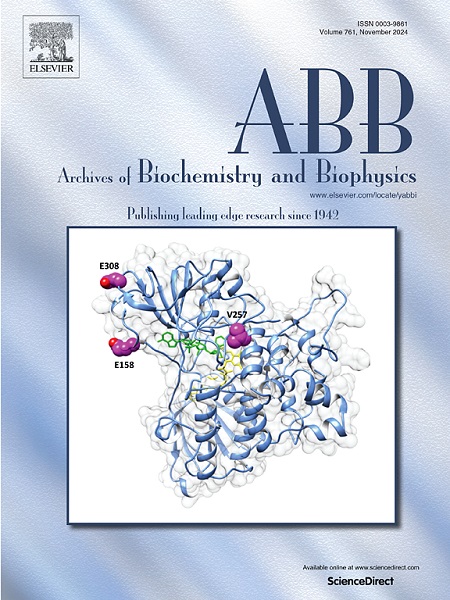Biophysical investigation of metal-substituted D-2-hydroxyglutarate dehydrogenase
IF 3.8
3区 生物学
Q2 BIOCHEMISTRY & MOLECULAR BIOLOGY
引用次数: 0
Abstract
D-2-Hydroxyglutarate dehydrogenase from Pseudomonas aeruginosa PAO1 (EC: 1.1.99.39; Uniprot ID: Q9I6H4) is a metallo-flavoenzyme that utilizes Zn2+ and FAD to catalyze the conversion of D-2-hydroxyglutarate to 2-ketoglutarate. The enzyme utilizes Co2+, Ni2+, Mn2+, and Cd2+ as alternative metal cofactors. To study how metal substitution impacts flavin properties, the enzyme was purified with different metal ions or treated with EDTA to generate the metallo-apoenzyme (EFAD-apo). Fluorescence assays revealed distinct metal ion binding sites in the enzyme: concentrations of metal ions up to ∼0.40 mM increased flavin fluorescence at 531 nm, whereas concentrations above ∼0.40 mM quenched flavin fluorescence with a 2–6 nm bathochromic shift. Concomitantly, enzyme-specific activity exhibited a sigmoidal increase, indicating a metal-induced conformational change. CD spectra showed no significant shifts at ∼209 and ∼220 nm but a ≤ 2-fold increase in mean residue ellipticity compared to EFAD-apo. Metal binding also caused a 2–9 nm bathochromic shift in flavin absorption and emission maxima, indicating stabilization of the excited-state flavin π-electron system. The binding of Zn2+, Co2+, Mn2+, or Cd2+ to the enzyme increased by ∼1 unit of the pKa value of the flavin N3 atom compared to the EFAD-apo, consistent with metal-hydrate perturbing flavin electronic properties. In contrast, Ni2+ binding decreased the pKa value, consistent with flavin N3 atom deprotonating before the Ni2+-hydrate in the enzyme active site. These findings reveal that metal ion substitution has minimal impact on the electronic properties of the flavin and the overall structural integrity of the enzyme, highlighting the potential use of metal-substituted variants of the enzyme as biomimetic catalysts.

金属取代d -2-羟基戊二酸脱氢酶的生物物理研究。
铜绿假单胞菌PAO1产d -2-羟戊二酸脱氢酶(EC: 1.1.99.39;Uniprot (ID: Q9I6H4)是一种利用Zn2+和FAD催化d -2-羟基戊二酸转化为2-酮戊二酸的金属黄酶。该酶利用Co2+, Ni2+, Mn2+和Cd2+作为替代金属辅因子。为了研究金属取代对黄素性质的影响,用不同的金属离子纯化酶或用EDTA处理生成金属脱酶(EFAD-apo)。荧光分析显示了酶中不同的金属结合位点:高达~ 0.40 mM的金属离子浓度增加了黄素荧光在531 nm处,而高于~ 0.40 mM的浓度使黄素荧光猝灭,产生2-6 nm的色移。同时,酶特异性活性呈s型增加,表明金属诱导的构象变化。CD光谱在~ 209和~ 220 nm处没有明显的变化,但与EFAD-apo相比,平均残基椭圆率增加了≤2倍。金属结合还引起黄素吸收和发射最大值的2 ~ 9 nm的色移,表明黄素π-电子系统的激发态稳定。与EFAD-apo相比,Zn2+、Co2+、Mn2+或Cd2+与酶结合的黄素N3原子的pKa值增加了~ 1个单位,这与金属水合物干扰黄素电子性质一致。相反,Ni2+结合降低了pKa值,这与酶活性位点Ni2+水合物发生前黄素N3原子去质子化一致。这些发现表明,金属离子取代对黄素的电子性质和酶的整体结构完整性的影响最小,突出了酶的金属取代变体作为仿生催化剂的潜在用途。
本文章由计算机程序翻译,如有差异,请以英文原文为准。
求助全文
约1分钟内获得全文
求助全文
来源期刊

Archives of biochemistry and biophysics
生物-生化与分子生物学
CiteScore
7.40
自引率
0.00%
发文量
245
审稿时长
26 days
期刊介绍:
Archives of Biochemistry and Biophysics publishes quality original articles and reviews in the developing areas of biochemistry and biophysics.
Research Areas Include:
• Enzyme and protein structure, function, regulation. Folding, turnover, and post-translational processing
• Biological oxidations, free radical reactions, redox signaling, oxygenases, P450 reactions
• Signal transduction, receptors, membrane transport, intracellular signals. Cellular and integrated metabolism.
 求助内容:
求助内容: 应助结果提醒方式:
应助结果提醒方式:


